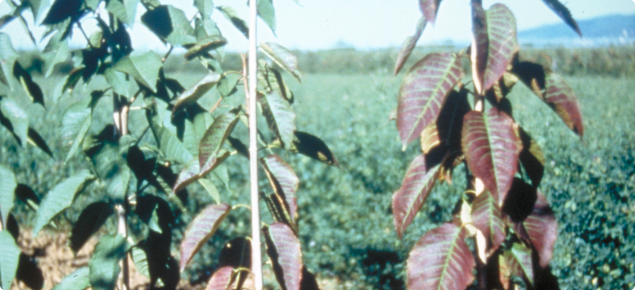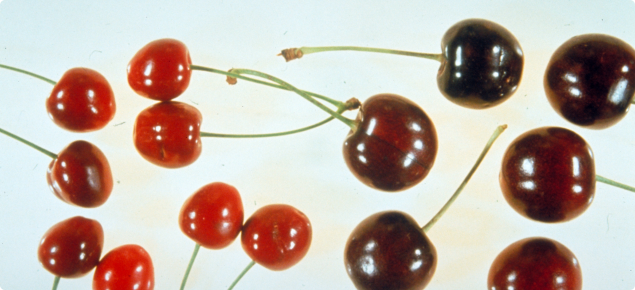Preferred scientific name
Ampelovirus Little cherry virus 2 (LChV-2)
Synonyms
Little cherry virus 2 (LChV-2)
Preferred common name
Little cherry disease (LCD)
Alternative common name
None known
Common host plants
LChV-2 is mostly a pathogen of:
- sweet cherry (Prunus avium)
- sour cherry (P. cerasus)
- flowering cherry (P. serrulata) (CAB International 2012).
It is rarely found in other hosts although it has been detected in plum (Prunus domestica) in Japan (Osman et al. 2012) and apple (Malus X domestica) in Germany (Eppler et al. 2001).
Plant part affected
Entire plant
Status in Western Australia
Ampelovirus Little cherry virus 2 (LChV-2) is considered to be absent from Western Australia and is a quarantine pest. It is a prohibited organism under section 12 of the Biosecurity and Agriculture Management Act 2007.
To confirm the current status please check the Western Australian Organism List. For more information on prohibited organisms please see frequently asked questions about the BAM Act and WAOL.
Biology and ecology
LCD is believed to be caused by two viral pathogens, Little cherry virus 1 (LChV-1) and the more recently described LChV-2 (Rott and Jelkmann 2001) which has similar symptoms and ecologies.
Symptoms are usually detected as fruits ripen, with infected fruits generally being smaller, discoloured and unpalatable (Rott and Jelkmann 2001). Often symptoms are not evident until there is a halting of the fruit maturation process within 10 days of harvest (New South Wales Department of Primary Industries 2013).
After harvest during late summer and leaf fall, leaves show a characteristic red coloration or bronzing of the surfaces. Flowering cherry plants are also entirely infected by LChV-2, however infection is usually asymptomatic (Rott and Jelkmann 2001).
There are often differences between the common edible cultivars, in terms of the severity of fruit and leaf symptoms (NSW Department of Primary Industries 2013). P. avium 'Bing' often produces infected fruits that are small and pointed in shape, discoloured and with an insipid flavour; whereas P. avium 'Van' fruits appear normal but are not flavoursome.
Fruit symptoms tend to be more severe in dark-fruited cultivars, and may also vary within a cultivar between seasons or growing regions.
Leaf symptoms are not evident in all cultivars, but are distinct in P. avium 'Bing' plants. During late summer or early autumn the interveinal areas of the upper leaf surface turn a red-violet or bronze colour while the midrib and main veins retain their green colour. This discolouration often appears on the lower leaves of the current season’s growth as the nights become cooler. In other cultivars, leaf symptoms are mild and may be characterised by only a slight upward leaf curl.
Apple mealybug (Phenacoccus aceris) has been reported as a vector of LChV-2 in several countries (CAB International 2012), and grape mealybug (Pseudococcus maritimus) has been reported to transmit LChV-2 between sweet cherry plants in the United States (Mekuria et al. 2013).
Both pests are likely to assist with short-distance dispersal of the virus between trees within an orchard or between adjacent orchards. Neither mealybug species is known to occur within Australia, and they are declared prohibited pests to Western Australia.
Plant Health Australia (2007) suggests there is uncertainty as to whether Australian mealybug species might vector LChV-2. Rott and Jelkmann (2001) suggest there may be other species of mealybugs, scale insects, or other insects that are yet to be determined as vectors of this virus.
LChV-2 is readily transmissible by grafting from any part of an infected tree, because virus particles are evenly distributed through an infected tree (Eastwell and Bernardy 2001, NSW Department of Primary Industries 2013). Hence LChV-2 may be spread long distances by the movement of infected nursery stock, rootstocks, scions and budwood. The virus is not known to be seed-borne.
Economic consequences
LCD directly affects fruit marketability and is one of the most economically important diseases of sweet cherry in North America (Eastwell and Bernardy 2001).
Since 2010 incidence of this disease as caused by LChV-2 has been observed to increase in orchards in Washington State (Mekuria et al. 2013). LCD is of such economic importance in western Canada that in some cherry growing regions it is illegal to import and grow ornamental flowering cherry because these cultivars may have asymptomatic infections of LChV-1 or LChV-2 (Rott and Jelkmann 2001).
LCD has also been reported as a serious outbreak in the Altes Land region of northern Germany (Rott and Jelkmann 2001).
What do I do if I find it?
Ampelovirus Little cherry virus 2 (LChV-2) is a prohibited organism for Western Australia. It is important that suspect disease occurrence is reported. Please contact the Pest and Disease Information Service (PaDIS) to report this pest.
References
CAB International 2012, Little cherry virus 2, Map 1133 (Edition 1).
Eastwell KC, Bernardy MG 2001, 'Partial characterization of a closterovirus associated with apple mealybug-transmitted little cherry disease in North America', Phytopathology vol. 91, pp. 268-273.
Eppler A, Ryback M, Kountrias A 2001, 'The distribution of little cherry disease in Germany: LChV1 AND LChV2 in cultivars of sweet cherry and in some other species', Mededelingen - Faculteit Landbouwkundige en Toegepaste Biologische Wetenschappen, Universiteit Gent, vol. 66, no. 2a, pp. 147-149.
Mekuria TA, Smith TJ, Beers E, Watson GW, Eastwell KC 2013, 'First report of transmission of Little cherry virus 2 to sweet cherry by Pseudococcus maritimus (Ehrhorn) (Hemiptera: Pseudococcidae)', Plant Disease vol. 97, no. 6, p. 851.
New South Wales Department of Primary Industries 2013, Exotic Pest Alert: Little cherry virus, Primefact 1296, Plant Biosecurity, Orange.
Osman F, Al-Rwahnih M, Golino D, Pitman T, Cordero F, Preece JE, Rowhani A 2012, 'Evaluation of the phytosanitary status of the Prunus species in the National Clonal Germplasm Repository in California: survey of viruses and viroids', Journal of Plant Pathology vol. 94, no. 1, pp. 249-253.
Plant Health Australia Ltd 2007, Industry Biosecurity Plan for the Cherry Industry (Version 2.01 - 2011), Plant Health Australia, Canberra, ACT.
Rott ME, Jelkmann W 2001, 'Detection and partial characterization of a second closterovirus associated with little cherry disease, Little cherry virus-2', Phytopathology vol. 91, no. 3, pp. 261-267.


